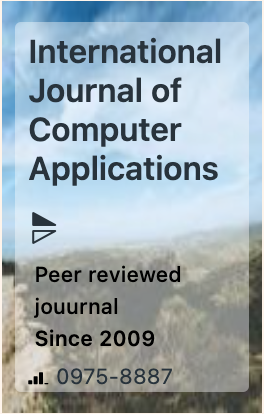The week's pick
Random Articles
Reseach Article
Cotton Leaf Disease Detection: An Integration of CBAM with Deep Learning Approaches
| International Journal of Computer Applications |
| Foundation of Computer Science (FCS), NY, USA |
| Volume 186 - Number 67 |
| Year of Publication: 2025 |
| Authors: Md Akash Rahman, Md. Safi Ullah, Rimon Kanthi Devnath, Taufiqul Hoque Chowdhury, Gulapur Rahman, Md Atikur Rahman |
 10.5120/ijca2025924487
10.5120/ijca2025924487
|
Md Akash Rahman, Md. Safi Ullah, Rimon Kanthi Devnath, Taufiqul Hoque Chowdhury, Gulapur Rahman, Md Atikur Rahman . Cotton Leaf Disease Detection: An Integration of CBAM with Deep Learning Approaches. International Journal of Computer Applications. 186, 67 ( Feb 2025), 1-8. DOI=10.5120/ijca2025924487
Abstract
Cotton is a major contributor to Bangladesh’s economy, serving as one of the primary cash crops. However, cotton production faces substantial challenges due to various diseases affecting the leaves, collectively referred to as Cotton Leaf Disease. Bacterial blight, leaf curl virus, fungal infections, and pest attacks negatively impact crop yield and quality, leading to economic losses. Conventional manual inspection techniques are inefficient, labor intensive, and prone to inaccuracies, which hinder timely disease identification and intervention. This study presents a deep learning system incorporating the Convolutional Block Attention Module (CBAM) for the automatic detection of cotton leaf diseases. A public dataset was utilized, consisting of 2,137 images in the original set and 7,000 images in the augmented set, categorized into seven classes: Bacterial Blight, Curl Virus, Herbicide Growth Damage, Leaf Hopper Jassids, Leaf Reddening, Leaf Variegation, and Healthy Leaf. Multiple deep learning models, including EfficientNetB1, DenseNet121, DenseNet169, MobileNet, Xception, and InceptionV3, were trained following the application of critical preprocessing techniques such as image resizing, noise reduction, and image normalization to improve image quality. The integration of CBAM into the models enhanced the emphasis on relevant image features, thereby improving detection performance. Among the models evaluated, DenseNet169 achieved an accuracy of 96.26% on the original dataset, whereas EfficientNetB1 with CBAM attained the highest accuracy of 99.21% on the augmented dataset.
References
- P. Bishshash, A. S. Nirob, H. Shikder, A. H. Sarower, T. Bhuiyan, and S. R. H. Noori, “A comprehensive cotton leaf disease dataset for enhanced detection and classification,” Data in Brief, vol. 57, p. 110913, 2024.
- A. Herok and S. Ahmed, “Cotton leaf disease identification using transfer learning,” in 2023 International Conference on Information and Communication Technology for Sustainable Development (ICICT4SD), pp. 158–162, IEEE, 2023.
- M. Ahmad, F. Ullah, A. R. A. Hamza, M. Usman, M. Imran, I. Batyrshin, A. Gelbukh, and G. Sidorov, “Cotton leaf disease detection using vision transformers: A deep learning approach,” crops, vol. 1, p. 3, 2024.
- S. Kumar, R. Ratan, and J. Desai, “Cotton disease detection using tensorflow machine learning technique,” Advances in Multimedia, vol. 2022, no. 1, p. 1812025, 2022.
- P. Udawant and P. Srinath, “Cotton leaf disease detection using instance segmentation,” Journal of Cases on Information Technology (JCIT), vol. 24, no. 4, pp. 1–10, 2022.
- G. Kumar, G. Singh, V. Bhatnagar, S. Rawat, and A. Bhardwaj, “Feature selection for cotton leaf disease using deep learning,” in 2024 IEEE International Conference on Communication, Computing and Signal Processing (IICCCS), pp. 1–6, IEEE, 2024.
- R. F. Caldeira, W. E. Santiago, and B. Teruel, “Identification of cotton leaf lesions using deep learning techniques,” Sensors, vol. 21, no. 9, p. 3169, 2021.
- S. Kotian, P. Ettam, S. Kharche, K. Saravanan, and K. Ashokkumar, “Cotton leaf disease detection using machine learning,” Proceedings of the Advancement in Electronics & Communication Engineering, 2022.
- B. N. Pandey, R. P. Singh, M. S. Pandey, and S. Jain, “Cotton leaf disease classification using deep learning based novel approach,” in 2023 International Conference on Disruptive Technologies (ICDT), pp. 559–561, IEEE, 2023.
- P. Singh, P. Singh, U. Farooq, S. S. Khurana, J. K. Verma, and M. Kumar, “Cottonleafnet: cotton plant leaf disease detection using deep neural networks.,” Multim. Tools Appl., vol. 82, no. 24, pp. 37151–37176, 2023.
- M. Zekiwos, A. Bruck, et al., “Deep learning-based image processing for cotton leaf disease and pest diagnosis.,” Journal of Electrical & Computer Engineering, 2021.
- P. Chopkar, M. Wanjari, P. Jumle, P. Chandankhede, S. Mungale, and M. S. Shaikh, “A comprehensive review on cotton leaf disease detection using machine learning method,” Grenze International Journal of Engineering and Technology, June Issue, Grenze ID, vol. 1, 2024.
- M. S. Memon, P. Kumar, and R. Iqbal, “Meta deep learn leaf disease identification model for cotton crop,” Computers, vol. 11, no. 7, p. 102, 2022.
- B. Jamadar, B. M. Harikant, B. Chaithra, J. Mohit, and V. Vasudevan, “Cotton leaf disease classification and pesticide recommendation,” in 2024 Second International Conference on Networks, Multimedia and Information Technology (NMITCON), pp. 1–7, IEEE, 2024.
- W. Guo, S. Feng, Q. Feng, X. Li, and X. Gao, “Cotton leaf disease detection method based on improved ssd,” International Journal of Agricultural and Biological Engineering, vol. 17, no. 2, pp. 211–220, 2024.
- W. Guo, S. Feng, Q. Feng, X. Li, and X. Gao, “Cotton leaf disease detection method based on improved ssd,” International Journal of Agricultural and Biological Engineering, vol. 17, no. 2, pp. 211–220, 2024.
- M. A. Rahman, M. Begum, T. Mahmud, M. S. Hossain, and K. Andersson, “Analyzing sentiments in elearning: A comparative study of bangla and romanized bangla text using transformers,” IEEE Access, 2024.
- B. V. Patil and P. S. Patil, “Computational method for cotton plant disease detection of crop management using deep learning and internet of things platforms,” in Evolutionary computing and mobile sustainable networks: proceedings of ICECMSN 2020, pp. 875–885, Springer, 2021.
- N. Parashar and P. Johri, “Deep learning for cotton leaf disease detection,” in 2024 2nd International Conference on Device Intelligence, Computing and Communication Technologies (DICCT), pp. 158–162, IEEE, 2024.
- S. Kumar, A. Jain, A. P. Shukla, S. Singh, R. Raja, S. Rani, G. Harshitha, M. A. AlZain, and M. Masud, “A comparative analysis of machine learning algorithms for detection of organic and nonorganic cotton diseases,” Mathematical Problems in Engineering, vol. 2021, no. 1, p. 1790171, 2021.
- C. M. Devi, S. P. Vishva, and M. M. Gopal, “Cotton leaf disease prediction and diagnosis using deep learning,” in 2024 International Conference on Advances in Computing, Communication and Applied Informatics (ACCAI), pp. 1–7, IEEE, 2024.
- M. R. Latif, M. A. Khan, M. Y. Javed, H. Masood, U. Tariq, Y. Nam, and S. Kadry, “Cotton leaf diseases recognition using deep learning and genetic algorithm.,” Computers, Materials & Continua, vol. 69, no. 3, 2021.
- A. Saini, K. Guleria, and S. Sharma, “Enhancing cotton leaf disease prediction by leveraging a fine-tuned convolutional neural network,” in 2024 Asia Pacific Conference on Innovation in Technology (APCIT), pp. 1–6, IEEE, 2024.
- G. Singh, R. Aggarwal, V. Bhatnagar, S. Kumar, and S. A. Dhondiyal, “Performance evaluation of cotton leaf disease detection using deep learning models,” in 2024 International Conference on Computational Intelligence and Computing Applications (ICCICA), vol. 1, pp. 193–197, IEEE, 2024.
- D. Menaga, B. S. Roshan, and S. S. Vikaas, “Cotton leaf disease based on image processing using deep learning,” in 2024 International Conference on Innovations and Challenges in Emerging Technologies (ICICET), pp. 1–8, IEEE, 2024.
Index Terms
Keywords

